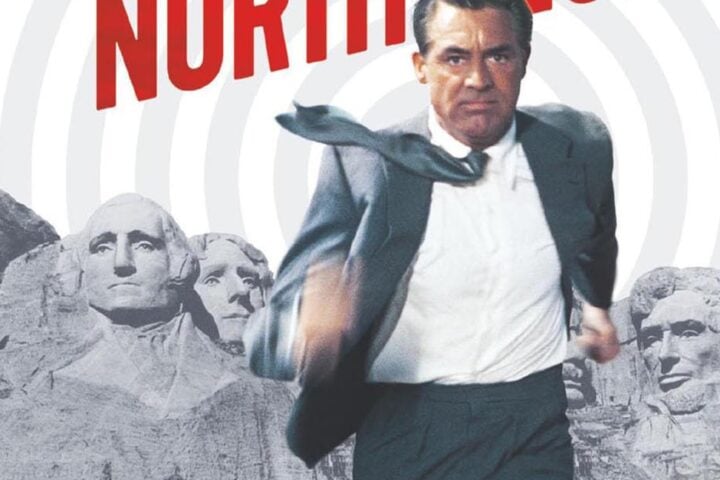Though undoubtedly effective as a classic Alfred Hitchcock thriller, Strangers on a Train is also nothing more complicated than one elongated gay cruising joke. Based on a Patricia Highsmith story (enough said), the film opens with a cross-cut montage of two sets of walking shoes, framed in medium shots, as the men wearning them get nearer to their train berths. Eventually, the sequence culminates in a flirtatious game of footsy. Bruno Anthony’s two-tone saddles are juxtaposed with Guy Haines’s monochromatically “sensible” shoes, saying in essence all that one needs to know about the politics of their impending liaison: Bruno is the flamboyant aggressor, the fire lit under Guy’s prudent ass.
Bruno (Robert Walker, in a performance that carefully juggles pussy-whipped nelliness and misogynistic wrath) casually suggests that they exchange murders to rid themselves of their own worst enemies. Guy (Farley Granger) is married to an inconvenient woman, Miriam (Kasey Rogers), who’s carrying someone else’s baby, while Bruno is engaged to his stunted, Oedipal sexual impulses. Naturally, that translates to getting rid of Daddy (Jonathan Hale), who seems to be the only one in the Anthony household willing to entertain the notion that Bruno ought to be institutionalized. (Given the sexual nature of Bruno’s condition, one wouldn’t be surprised if Dad defined institutionalization as a trip to the whorehouse.)
Bruno keeps up his end of the bargain and murders Guy’s wife, in a spectacular, nearly dialogue-free sequence that, in its combination of voyeurism, prowler instinct, and violent eroticism, seems to be the primary influence on Brian De Palma’s Dressed to Kill’s museum pick-up. Unfortunately, Guy reactively pulls out when the reality of his bargain hits home, leaving Bruno hanging out to dry. What’s a spurned confidante (closet lover) to do? Integrate himself into Guy’s social circle and carry with him the threat of exposure and public shame.
It’s debatable how much of this queer subtext Hitchcock intended Strangers on a Train to hold—especially taking into consideration the rumor that many of the coded elements of Raymond Chandler’s original script were reportedly neutered in Czenzi Ormonde’s final one. Still, it’s worth noting that it does in some small measure validate one of Hitchcock’s most dubious motifs: his stock characterizations of aged women as nothing more than hideously plump, turkey-necked, gossip-addicted pension leeches, already embalmed with their own plumage.
But to ignore the subtext during the runaway carousel climax is to be absolutely blind. As Guy and Bruno’s erotic one-upmanship reaches its breaking point, they’re surrounded by contorted petrified horses whose pinions look like they’re angrily violating their sockets. It’s downright pornographic, and the force of the scene almost seems to emanate from the sense that the erotic power between the two was out of even Hitchcock’s control.
Image/Sound
Strangers on a Train comes in two cuts here: the final 101-minute release version and the 103-minute “preview version” (though the second could just as easily be taken as an extra feature and not a main course). They actually look pretty comparable (and, try as I might, I couldn’t pick up on the subtle differences between the cuts except for that the preview version ended on a note of unbelievable schmaltz, whereas the final version has a mildly tacked-on coda featuring Guy rejecting a second gentleman caller). Though the preview version comes from a slightly more worn-looking print, they both look sensational, with sharp focus and no artifacts. These are stunning looking discs. The mono sound mix (the final version also includes a mono French track) is passable, without much dynamic range (at least it’s not near-silent like some other discs in this Warner Bros. Hitchcock series).
Extras
Warner’s Hitchcock collection discs are mostly thin on features (though the docs that accompany all the titles are typically professional). Strangers on a Train is the exception. Aside from the alternate version, here we have a running commentary track with Peter Bogdanovich (who contributes most of the insightful-if-already-well-acknowledged elements of the film and its place in the Hitchcock legacy), Joseph Stefano, and about two dozen other people. Also pasted into the track is Alfred Hitchcock from interview tapes. It’s all a little bit dizzying, but it has been put together in a sensible manner. The obligatory “making of” documentary is twice as long (40 minutes) as the docs on most of the other discs, and includes more interview subjects as well. It’s hardly surprising that a blind eye is turned, in general, to the gay subtext that is so clearly filling Strangers on a Train’s gas tank, though a short appreciation of the film from M. Night Shyamalan (in his open-collared raspberry shirt and his emo half-mohawk) comes frustratingly close (filing all of Bruno’s eccentricities under the umbrella heading of “insane” in a way that Hitchcock never succumbs to). Two other short featurettes: The Victim’s P.O.V., which is mostly an interview with Kasey Rogers about her distinctive specs, and The Hitchcocks on Hitch, which is basically the sort of Cliffs Notes biography that fills the gaps between films on the Turner Classic Movies network. Finally, there is the theatrical trailer and silent newsreel footage of Hitchcock standing next to a train with two extras dressed in baroque French drag.
Overall
In Hitchcock’s gay burlesque, Farley Granger learns the hard way not to lick what he can’t swallow.
Since 2001, we've brought you uncompromising, candid takes on the world of film, music, television, video games, theater, and more. Independently owned and operated publications like Slant have been hit hard in recent years, but we’re committed to keeping our content free and accessible—meaning no paywalls or fees.
If you like what we do, please consider subscribing to our Patreon or making a donation.



